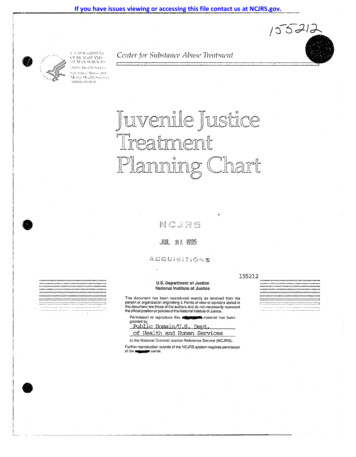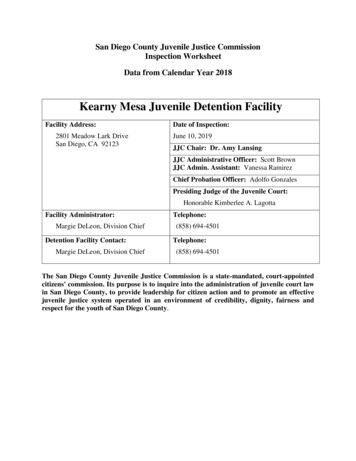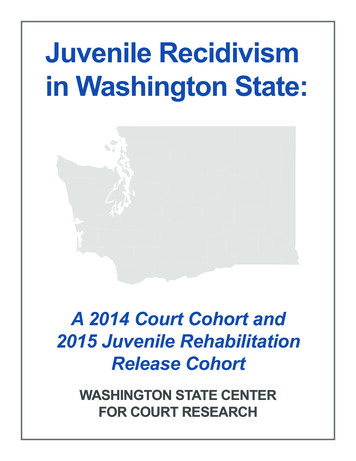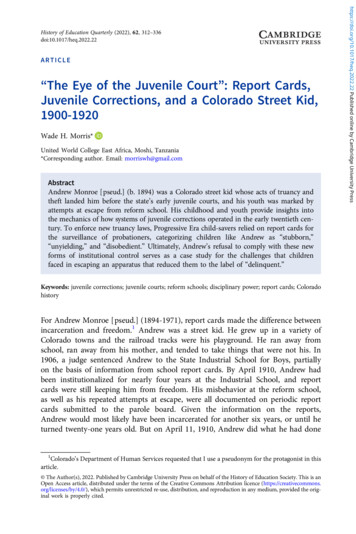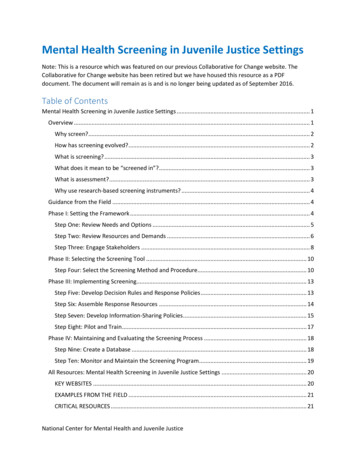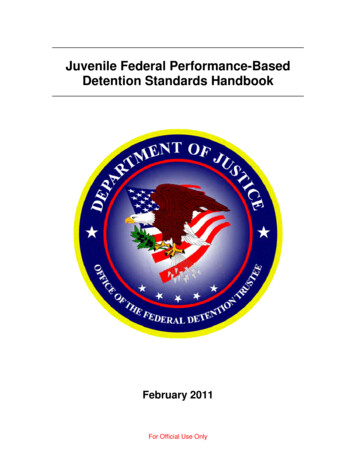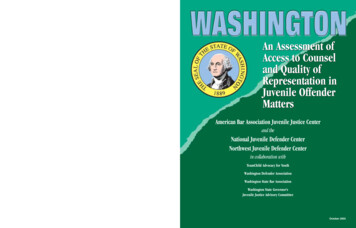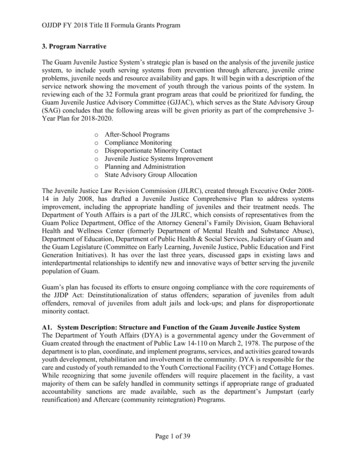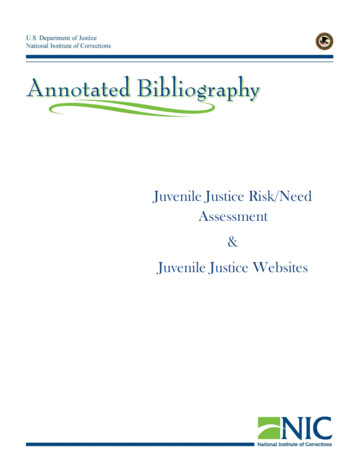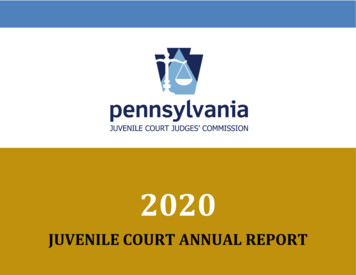
Transcription
2020JUVENILE COURT ANNUAL REPORT
2020PENNSYLVANIAJuvenile Court Annual ReportCOMMONWEALTH OF PENNSYLVANIAHon. Tom Wolf, GovernorJUVENILE COURT JUDGES’ COMMISSIONCHAIRHon. Kim Berkeley ClarkAllegheny CountyVICE-CHAIRHon. David R. WorkmanLancaster CountySECRETARYHon. Stephen P.B. MinorPotter CountyMEMBERSHon. J. Brian JohnsonLehigh CountyHon. Walter J. OlszewskiPhiladelphia CountyHon. Joy Reynolds McCoyLycoming CountyHon. Mitchell ShahenBeaver CountyHon. Margaret T. MurphyPhiladelphia CountyHon. Maureen A. SkerdaWarren/Forest CountiesRichard D. SteeleExecutive Director
2020PENNSYLVANIAJuvenile Court Annual ReportJUVENILE COURT JUDGES’ COMMISSIONAdministrative OfficesRichard D. Steele, Executive DirectorRobert J. Tomassini, Deputy DirectorAdmin. Assistant, VacantSusan BarketCourt Consultant, VacantLeo J. LutzKeysla RodriguezMichael SchlossmanAngel StewartAngela WorkCenter for Juvenile Justice Training and ResearchDirector, VacantMichael Tan, Director of ITDRebecca AndersonHeather Armstrong-ShughartSeth BloomquistDawn ButtsJulie ByersSusan ConnerRobert DiehlJuvenile Court Judges’ Commission601 Commonwealth Avenue, Suite 9100P.O. Box 62425Harrisburg, PA 17106-2425717-787-6910Randy FisherChris HeberligLanette HutchisonMonica IskricIT Generalist, VacantBarbara MullChristy Nailorwww.jcjc.pa.govJames StewartSonya StokesTyler TomlinsonSherry VarnerSteve VarnerJarrett VoightNancy WitterCenter for Juvenile Justice Training and ResearchShippensburg University1871 Old Main DriveShippensburg, PA 17257-2299717-477-1195
ForewordThe Juvenile Court Judges’ Commission (JCJC) is pleased to present the fourth edition of its Juvenile Court Annual Report. Prior to the publication of the 2017 report,Pennsylvania juvenile court statistics were presented in a yearly series entitled Pennsylvania Juvenile Court Dispositions. The series, which ran from 1972 to 2016,focused primarily on juvenile court dispositions.Beginning in 2017, the annual report has been enhanced to include additional juvenile court statistics to better measure and quantify work across the state by juvenilejustice professionals. Specifically, information related to delinquency allegations received by each juvenile probation department is included. Key indicators including thevolume of allegations received, allegation sources, and the most serious alleged offense by youth are presented. This information is critical to understanding who isentering Pennsylvania’s juvenile court system. It is anticipated this report will continue to evolve over time and will eventually include additional measures of juvenilejustice workflow in Pennsylvania. Juvenile delinquency dispositions continue to be summarized in this report, as in the past.Beginning in 2019, the detention data within this report was extracted directly from the Pennsylvania Juvenile Case Management System (PaJCMS). Prior to 2019, thisdata was received from juvenile detention centers and included a significant number of unreported detention codes. By using data taken directly from PaJCMS, thenumber of unreported detention section codes decreased from 16.0% in 2018 to 0.7% in 2020, providing a more accurate reflection of secure detention utilization.The format and presentation of the data in this report are intended to help summarize various juvenile court trends within the Commonwealth. In addition to the graphs andcharts, narrative is included to help readers more quickly recognize various statewide trends, as well as highlight informati on not reflected in the visual displays. The data withinthis year’s report are generally organized in a manner that reflect the chronological processing of juvenile court delinquency cases, fro m allegation through disposition. Some ofthe data are organized and presented in graphs by county class to help readers make comparisons across counties of similar size and demographic composition. Raw data for eachof Pennsylvania’s 67 counties are available within the appendices.The Annual Report generally describes trends and patterns, without seeking to interpret them—though there are some exceptions made in this year’s report given thepervasive effects of COVID-19 on the juvenile court system. The goal of Chapter 3 in this year’s report is to further analyze and explain how the pandemic affected thejuvenile justice system. Therefore, hypotheses for the observed trends are discussed when they seem reasonable based on the data and other evidence or knowledge abouthow the juvenile justice system functions.The JCJC would like to extend its deepest appreciation to the juvenile courts and juvenile probation departments across the Commonwealth. Without their support, thisreport would not be possible. It is with great pleasure that we dedicate this report to the judges, probation officers, victim advocates, district attorneys, defenders, serviceproviders, and other professionals who work on a daily basis in the Pennsylvania juvenile court system.Respectfully submitted,Richard D. SteeleExecutive DirectorHonorable Kim Berkeley ClarkChair
Table of Contents2020 Statistical Highlights .1Chapter 1 – Incoming CasesSection 1: Delinquency Allegations .22020 Delinquency Allegations (Map) .32020 Delinquency Allegations by County Class (Map) .4Delinquency Allegations, 2016-2020 .5Percentage of Juvenile Population Receiving Allegations, 2016-2020.5Delinquency Allegations and Juvenile Totals .6Delinquency Allegations by Gender .7Delinquency Allegations by Race and Ethnicity .7Source of Allegation .8Delinquency Allegations by Age at Offense .9Delinquency Allegations by Offense Type, 2016-2020 . 10Delinquency Allegations Most Frequent Alleged Offense Categories . 11Section 2: Secure Detention . 12Codes Related to JCJC Standards Governing the Use of Secure Detention Under the Juvenile Act . 12Secure Detention Admissions, 2016-2020 . 13Length of Stay in Secure Detention . 14Secure Detention Admissions by Standard Section Codes . 15Secure Detention Admissions by Standard Section Codes, 2016-2020 . 16Utilization Rates for Pennsylvania Juvenile Detention Centers . 17
Chapter 2 – Juvenile Court ProcessingSection 1: Delinquency Dispositions. 182020 Delinquency Dispositions (Map) . 192020 Delinquency Dispositions by County Class (Map) . 20Delinquency Dispositions, 2016-2020. 21Percentage of Juvenile Population Receiving Delinquency Dispositions, 2016-2020 . 22Delinquency Dispositions and Juvenile Totals . 22Frequencies of Statewide Delinquency Dispositions . 23Delinquency Dispositions by Source of Allegation . 24Attorney Representation in Formal Delinquency Proceedings . 24Most Serious Alleged Offenses by Type . 25Most Serious Substantiated Offenses by Type . 25Most Frequent Alleged Offense Categories . 26Section 2: Demographics. 27Selected Dispositions by Gender . 27Delinquency Dispositions by Age at Disposition . 28Delinquency Dispositions by Educational Status . 29Delinquency Dispositions by Family Status . 30Section 3: Race and Ethnicity . 31Total Delinquency Dispositions by Race and Ethnicity . 32Selected Delinquency Dispositions by Race and Ethnicity . 33Secure Detention by Race and Ethnicity . 35Transferred to Criminal Proceedings by Race and Ethnicity . 35
Section 4: Delinquency Placements . 36Delinquency Placements, 2016-2020. 36Delinquency Placements as a Percent of Dispositions, 2016-2020 . 372020 Delinquency Placements as a Percent of Dispositions (Map). 38New Allegation Placements vs. Disposition Review Placements . 39Total Delinquency Placements by Type . 41Section 5: Delinquency Disposition and Placement Reviews . 42Outcomes of Delinquency Disposition Reviews . 42Outcomes of Delinquency Placement Reviews. 43Section 6: Dependency Dispositions . 44Dependency Dispositions . 44Dependency Dispositions by Age . 45Chapter 3 – The Impact of COVID-19 on Pennsylvania’s Juvenile Justice SystemOverview . 46Impact of COVID-19 Statistical Highlights . 47Section 1: Written Allegations. 48Written Allegations by Month, 2019-2020 . 48Top Ten Offenses with the Largest Decreases in Written Allegations Between 2019 and 2020 for the Pandemic Months . 49Section 2: Court Hearings and Case Processing . 50Court Hearings Held by Month, 2019-2020. 50Percentage of Hearings Held In-Person, by Phone, or Video Conference by Month, 2020 . 51COVID-19 Response in Pennsylvania’s Juvenile Probation Departments, Surveys #2 and #4 . 52Case Processing of New Allegation Dispositions by Month, 2020 . 53
Section 3: Out-of-Home Placements . 54Number of Youth in Out-of-Home Placement on the First Day of the Month, 2019-2020 . 54Out-of-Home Placement Dispositions by Month, 2019-2020 . 55Releases from Placement by Month, 2019-2020 . 56Number of Placement Releases Per Month as a Percentage of Youth in Out-of-Home Placementon the First Day of the Month, 2019-2020 . 57AppendicesAppendix 1: County Class and Population . 58Appendix 2: Delinquency Allegations, 2016-2020 . 59Appendix 3: Delinquency Allegations as a Percent of Juvenile Population . 61Appendix 4: Delinquency Allegations by Gender, Race, and Ethnicity . 63Appendix 5: Delinquency Allegations by Source of Allegation. 65Appendix 6: Delinquency Allegations by Age at Offense . 67Appendix 7: Delinquency Allegations by Offense Type . 71Appendix 8: Number of Admissions and Length of Stay in Secure Detention . 73Appendix 9: Secure Detention Admissions by Standard Section Codes . 75Appendix 10: Secure Detention Admissions by Section Code 206 and County Class . 77Appendix 11: Secure Detention Admissions by Section Code 701 and County Class . 79Appendix 12: Secure Detention Admissions by Unknown/Other Code and County Class . 80Appendix 13: Delinquency Dispositions, 2016-2020 . 81Appendix 14: Delinquency Dispositions as a Percent of Juvenile Population. 83Appendix 15: Delinquency Dispositions by Type . 85Appendix 16: Delinquency Dispositions by Source of Allegation . 89Appendix 17: Type of Attorney Representation in Delinquency Proceedings . 91
Appendix 18: Most Serious Alleged Offenses by Type . 93Appendix 19: Most Serious Substantiated Offenses by Type . 95Appendix 20: Delinquency Dispositions by Age at Disposition . 97Appendix 21: Delinquency Dispositions by School Status . 101Appendix 22: Delinquency Dispositions by Highest Grade Completed . 103Appendix 23: Delinquency Dispositions by Family Status . 105Appendix 24: Delinquency Dispositions by Living Arrangement of Youth . 107Appendix 25: Delinquency Dispositions by Race and Ethnicity . 109Appendix 26: Secure Detention Admissions by Race and Ethnicity. 111Appendix 27: Delinquency Placements Including Disposition Reviews, 2016-2020 . 113Appendix 28: Delinquency Placements by Type . 115Appendix 29: Outcomes of Delinquency Disposition Reviews . 119Appendix 30: Outcomes of Delinquency Placement Reviews . 121Appendix 31: Delinquency Placement Review Transfers by Type of Placement . 123Appendix 32: Summary of All Delinquency and Dependency Dispositions . 127Appendix 33: Written Allegations by County by Month, 2019-2020. 129Appendix 34: Court Hearings Held by County by Month, 2019-2020 . 133Appendix 35: Number of Youth in Out-of-Home Placement by County on the First Day of the Month, 2019-2020 . 137Appendix 36: Out-of-Home Placement Dispositions by County by Month, 2019-2020. 141Appendix 37: Releases from Placement by County by Month, 2019-2020 . 145Glossary . 149
2020 Statistical Highlights12020 Juvenile Court Annual Report
Chapter 1 - Incoming CasesSection 1: Delinquency Allegations1. The unit of count for this section is a written allegation. A written allegation is the document submitted by a law enforcement officer or otherperson to allege a juvenile has committed an act of delinquency. Multiple allegations may result in a single disposition. Allegations are synonymouswith the term ‘case’ in the Pennsylvania Juvenile Case Management System (PaJCMS).2. Written allegations in this section were filed with a juvenile probation department between January 1, 2020 and December 31, 2020.3. In Pennsylvania, juvenile court jurisdiction extends over individuals who have
3. In Pennsylvania, juvenile court jurisdiction extends over individuals who have been alleged to have committed a delinquent act, as defined by 42 Pa. C. S. § 6301 et seq., on or after their tenth birthday and prior to reaching eighteen years of age. Juvenile court supervision can extend until the

